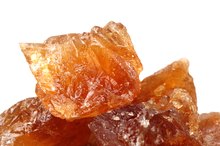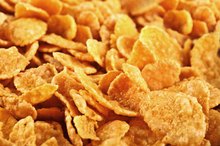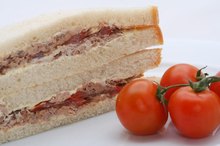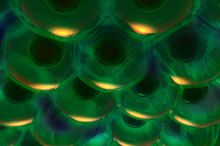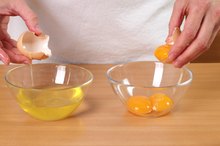What is the Complete Oxidation of a Glucose Molecule?
Oxidation is a chemical process that, loosely defined, involves removing electrons from particular areas of a molecule. In biochemical processes, oxidation generally results in the release of energy. As such, when you "burn" glucose for energy, your cells are actually oxidizing the glucose molecule to produce the products carbon dioxide and water.
Glucose
The glucose molecule contains stored energy in its bonds, just as other nutrient molecules do, including starch, proteins and fats. When you consume food that contains glucose, you digest the food and absorb the glucose into your bloodstream. From there, cells take up the glucose and either store it for later use or chemically burn it to provide energy. Oxidation of glucose is analogous to burning wood in many ways: It releases chemical energy.
- The glucose molecule contains stored energy in its bonds, just as other nutrient molecules do, including starch, proteins and fats.
- From there, cells take up the glucose and either store it for later use or chemically burn it to provide energy.
Glycolysis
Why Do We Need Glucose in Our Diet?
Learn More
The process of complete glucose oxidation begins with a cell splitting a glucose molecule into two molecules of pyruvate, explain Drs. Reginald Garrett and Charles Grisham in their book "Biochemistry." This takes place through a series of 10 reactions collectively called glycolysis 1. Splitting of glucose into pyruvate represents a partial oxidation of glucose and occurs with the release of a small amount of energy. Complete oxidation of glucose, however, requires additional reactions.
- The process of complete glucose oxidation begins with a cell splitting a glucose molecule into two molecules of pyruvate, explain Drs.
- Splitting of glucose into pyruvate represents a partial oxidation of glucose and occurs with the release of a small amount of energy.
Kreb's Cycle
The remainder of glucose oxidation occurs via a series of reactions called the Kreb's Cycle. These reactions modify pyruvate to produce a molecule called acetyl-CoA, which then undergoes a series of eight additional reactions, explain Drs. Mary Campbell and Shawn Farrell in their book "Biochemistry." At the end of the Kreb's Cycle, glucose is completely oxidized and all the available energy from the original glucose molecule has been released and gathered by the cell 2.
- The remainder of glucose oxidation occurs via a series of reactions called the Kreb's Cycle.
- These reactions modify pyruvate to produce a molecule called acetyl-CoA, which then undergoes a series of eight additional reactions, explain Drs.
Products
Carbohydrates & Respiration
Learn More
The products of complete glucose oxidation are carbon dioxide and water. Because these molecules represent the products of a thorough energy extraction, they're essentially cellular waste products -- the cell can't use them to provide additional energy. Cells recycle water produced through glucose oxidation. Carbon dioxide, however, diffuses into the bloodstream and travels to the lungs. From there, you exhale it. In essence, when you consume and burn glucose, you breathe out the products of glucose oxidation.
- The products of complete glucose oxidation are carbon dioxide and water.
- In essence, when you consume and burn glucose, you breathe out the products of glucose oxidation.
Related Articles
References
- “Biochemistry”; Reginald Garrett, Ph.D. and Charles Grisham, Ph.D.; 2007
- “Biochemistry”; Mary Campbell, Ph.D. and Shawn Farrell, Ph.D.; 2005
- American Diabetes Association. 5. Lifestyle management: Standards of medical care in diabetes-2019. Diabetes Care. 2019;42(Suppl 1):S46-60. doi:10.2337/dc19-S005
- National Institute of Diabetes and Digestive and Kidney Diseases. Diabetes diet, eating, & physical activity. Published December 2016.
- American Diabetes Association. The big picture: Checking your blood glucose.
- American Diabetes Association. 6. Glycemic Targets: Standards of Medical Care in Diabetes-2020. Diabetes Care. 2020;43(Suppl 1):S66-S76. doi:10.2337/dc20-S006
- American Diabetes Association. 14. Management of diabetes in pregnancy: Standards of medical care in diabetes-2020. Diabetes Care. 2020;43(Suppl 1):S183-S192. doi:10.2337/dc20-S014
- Porcellati F, Lucidi P, Bolli GB, Fanelli CG. Thirty years of research on the dawn phenomenon: Lessons to optimize blood glucose control in diabetes. Diabetes Care. 2013;36(12):3860-2. doi:10.2337/dc13-2088
- American Diabetes Association. 5. Lifestyle management: Standards of medical care in diabetes-2019. Diabetes Care. 2019;42(Suppl 1):S46-60. doi:10.2337/dc19-S005
- Colberg SR, Sigal RJ, Yardley JE, et al. Physical activity/exercise and diabetes: A position statement of the American diabetes association. Diabetes Care. 2016;39(11):2065-2079. doi:10.2337/dc16-1728
- American Diabetes Association (ADA). Understanding A1C.
- Garber AJ, Abrahamson MJ, Barzilay JI, et al. Consensus statement by the American association of clinical endocrinologists and American college of endocrinology on the comprehensive type 2 diabetes management algorithm - 2019 executive summary. Endocr Pract. 2019;25(1):69-100. doi:10.4158/CS-2018-0535
Writer Bio
Kirstin Hendrickson is a writer, teacher, coach, athlete and author of the textbook "Chemistry In The World." She's been teaching and writing about health, wellness and nutrition for more than 10 years. She has a Bachelor of Science in zoology, a Bachelor of Science in psychology, a Master of Science in chemistry and a doctoral degree in bioorganic chemistry.
